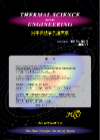All issues

Volume 19 (2011)
- Issue 4 Pages 95-
- Issue 3 Pages 59-
- Issue 2 Pages 43-
- Issue 1 Pages 1-
Volume 19, Issue 3
Displaying 1-3 of 3 articles from this issue
- |<
- <
- 1
- >
- >|
-
Yoshinobu YAMAMOTO, Tomoaki KUNUGI, Yoshiyuki TSUJI2011Volume 19Issue 3 Pages 59-70
Published: 2011
Released on J-STAGE: November 20, 2011
JOURNAL FREE ACCESSIn this study, the essential spatial resolution for Direct numerical simulation (DNS) of passive scalar transport in a channel flow was investigated at friction Reynolds number Reτ = 150 and Prandtl number Pr = 5 by using the high accuracy DNS data, which resolved full scales of second-order temperature derivative. In spite of lack the spatial resolution less than dynamical velocity fluctuations, the coarser DNS results were finely agreed with the high accuracy DNS results, as far as Nusselt number to temperature turbulent energy dissipation. This is why the larger scale in the temperature inertial range plays the role of the real dissipative smaller scale. Results of finer numerical grids for temperature field than velocity field, follow the temperature spectrum profile in the range of the fine smallest scale. It indicates that dynamical process in the velocity dissipative range might not impact on the statistic behavior of the smallest temperature scale.View full abstractDownload PDF (1266K) -
Koichi ICHIMIYA, Koji TORIYAMA2011Volume 19Issue 3 Pages 71-80
Published: 2011
Released on J-STAGE: November 20, 2011
JOURNAL FREE ACCESSThe flow and heat transfer characteristics of the mixed convection in a horizontal square duct, whose side walls and bottom wall are heated in uniform temperature and upper wall is insulated thermally, are examined numerically in three-dimensional system and transient process. The SIMPLE algorithm and QUICK scheme are applied to solve the governing equations through a control volume. The working fluid is water, and the temperature dependence of kinetic viscosity ν and thermal conductivity λ of water is considered in this analysis. Numerical results show that the reverse flow, the spiral flow and two-recirculating flows appear on the upper wall, along the flow direction and near the bottom wall, respectively. The local Nusselt numbers are presented corresponding to the transient flow behavior.View full abstractDownload PDF (4106K) -
Takashi FUKUE, Masaru ISHIZUKA, Kenta YAMAZAKI, Tomoyuki HATAKEYAMA, S ...2011Volume 19Issue 3 Pages 81-93
Published: 2011
Released on J-STAGE: November 20, 2011
JOURNAL FREE ACCESSA model of electronic equipment considered in the present study has the characteristics that are commonly seen in modern compact electronic equipment. It has a set of multiple (five) heat sources distributed over a 8 x 10 cm2 board. The equipment box is so thin that cooling air is permitted only in a corner of the box where a finned heat sink (1 cm (H) x 2 cm (W) x 6 cm (L)) is installed on the board. Heat from the heat sources is conducted through the board, and dissipated to the air from the heat sink. The model has a level of physical complexity that requires very large computational resources if computational fluid dynamic (CFD) analysis is performed. Resistance network analysis allows fast analysis of airflow and heat transfer; however, the estimation of resistance elements in the airflow and thermal networks holds the key to achieve high accuracy of analysis. Actual processes of airflow and heat transfer are complex when examined locally. In the present report we show how such locally complex physical processes can be represented by resistance elements. The analytical results are compared with the experimental data. Good agreement between them validates our methodology.View full abstractDownload PDF (3190K)
- |<
- <
- 1
- >
- >|